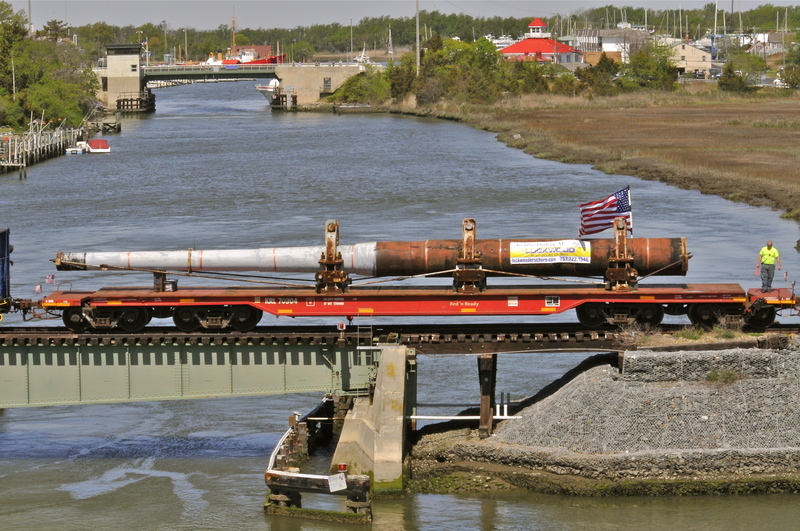A rusty gun barrel from the USS Missouri was destined to be sold for scrap - until the Fort Miles Historical Association took on the mission of preserving it as a relic of World War II history.
Now the gun is an honored guest, waiting to be unveiled Saturday, April 28, at Fort Miles in Cape Henlopen State Park.
Dan Clark, the man in charge of moving the 120-ton USS Missouri gun barrel to Fort Miles, said he has gained a better understanding of what the massive piece of history means to people. As he rode aboard a caboose on the Delaware Coast Line Railroad train April 17 moving the barrel from Georgetown to Lewes, he was overwhelmed by the outpouring of support.
“The neatest thing so far was riding that train and seeing the unbelievable number of people who showed up along the tracks,” he said. “There were flags waving and people saluting along the whole route.”
It's been that kind of journey for the gun barrel that was among the nine aboard the USS Missouri, one of the most famous battleships in naval history. It's attracted attention all across the Delmarva Peninsula as it made the trip via rail from Cape Charles, Va.
The U.S. Navy donated the gun to the society, but it took months of planning and more than $100,000 to move it from Norfolk, Va., to Lewes.
The historic gun arrives in Lewes
The historic Missouri gun barrel arrived via rail in Lewes at 11 a.m. April 17 and was transferred the next day on a 96-wheel tractor-trailer to its new home at Fort Miles in Cape Henlopen State Park.
Since its arrival in Sussex County last week in Georgetown, the 66-foot gun barrel from the historic battleship has attracted more than its far share of attention. The gun was welcomed to Sussex County with an April 16 ceremony on The Circle in Georgetown and will be dedicated Saturday, April 28, at its new home.
Hundreds followed its move on a Delaware Coast Line Railroad train April 17 from Georgetown to Lewes. Groups gathered at each rail crossing and hundreds stopped by to take photographs at the switching yard behind the Lewes library and then along the Freeman Highway bridge as it crossed the hand-cranked trestle bridge.
Dozens more gathered early April 18 as the task began to transfer the gun barrel from a railcar to a trailer for transport to Fort Miles. Escorted by police, the trailer took the gun into the park around 2 p.m., delivering it to the park's gun emplacement.
Even though the gun is officially on the ground in the park, Fort Miles Historical Association members say it will take another two years before the static display of the gun is completed. More money is needed to complete the project.
The gun is the missing piece in the Fort Miles arsenal. Crews manned a pair of similar 16-inch guns in bunkers during World War II.
Sussex County welcomes historic gun barrel
An April 16 ceremony in Georgetown was billed by its organizers as a welcoming ceremony for the 16-inch gun, but also as a time to honor veterans. After the ceremony on the unusually hot 89-degree April day, veterans and family members joined in a march led by the Sussex Tech band and members of the American Legion Post 28 motorcyclists to the gun barrel located in a switching yard about four blocks away.
Among the list of 16 speakers were two veterans who have personal memories of the historic battleship that not only saw action in World War II but also in the Korean War and conflicts in the Middle East.
Retired Col. Newt Tyndall, 93, of Georgetown has the distinction of serving as navigator on the lead B-29 bomber that flew over the historic battleship during the Sept. 2, 1945 Japanese surrender ceremony, which took place beneath the 16-inch gun barrel now at Fort Miles. His bomber led a flyover of 400 bombers over Tokyo Bay.
Tyndall enlisted two weeks after the attack on Pearl Harbor and served stateside as a flight instructor for two years before he volunteered for what was then a new B-29 program. “Volunteering for the B-29 program - I'm proudest of that more than anything I've ever done,” he said, his voice cracking.
He completed 25 combat missions, but his final flight ranks among the most memorable. His final flyover for the Japanese surrender also meant he was close to getting home at war's end.
“Judge” Richard Snyder of Georgetown served on the USS Missouri in 1950 and 1951 during the Korean War. He has vivid memories of the constant 24-hour bombardment of the Korean coast, yet the journey from the United States to Korea was filled with memories as well.
The ship had to pass through two days of a hurricane along the East Coast of the United States and then a memorable trip through the Panama Canal. “There was one foot left open on each side,” Snyder recalled. Then came the sail across the Pacific, which included a typhoon for two days after leaving Pearl Harbor in Hawaii en route to the fighting in Korea.
He said the massive ship was as long as three football fields and weighed 45,000 tons. The ship's 16-inch guns could hurl a shell almost 25 miles.
He said the bombardment of Korea was nonstop, and crew members were lucky to get two or three hours of sleep each night.
The USS Missouri is now a museum ship docked in Pearl Harbor near the USS Arizona Memorial.
Snyder called the two battleships the Alpha and Omega of World War II - the Arizona was among the first casualties of the Dec. 7, 1941 attack on Pearl Harbor, while the USS Missouri served as the ship where the surrender ceremony occurred ending the War in the Pacific.
The USS Missouri was the scene. On Sept. 2, 1945, a contingent from Japan landed on the USS Missouri in the middle of Tokyo Bay to surrender to the Allies. The Japanese delegation walked past several of the enormous cannons that had battered the mainland for weeks on end, finally meeting with Gen. Douglas MacArthur and other Allied leaders on the deck of the celebrated vessel.
“All of us at the Fort Miles Historical Association are excited that this barrel from one of history’s most storied battleships will be on permanent display at our facility,” said Gary Wray, president of the association.
Team effort makes dream a reality
Wray first had the vision to obtain a 16-inch gun barrel to complement the fort's impressive display. Fort Miles had a pair of similar 16-inch guns in bunkers to guard the mouth of Delaware Bay during World War II.
The USS Missouri gun barrel will be the showcase display for a World War II museum planned for Fort Miles in Cape Henlopen State Park.
Wray said the project, which took more than a year, was a team effort headed by a dedicated fundraising committee that raised more than $100,000 to transport the gun barrel to Lewes from Norfolk. Wray said under the leadership of Nick Carter of Lewes, the committee's account went from zero dollars on Jan. 1 to $130,000 on Dec. 31, 2011.
Wray had special praise for staff at Cape Henlopen State Park, where the Missouri barrel will be displayed. The project is not completed, as another $200,000 to $250,000 will be needed to renovate the gun and and place it in a carriage.
Linda Parkowski said it best. “We shouldn't have been skeptical that this could be pulled off when we have dedicated volunteers united by a common purpose, just like those who served in World War II,” she said. Parkowski is executive director of the Delaware Tourism Office.
Wray was presented with tributes from the Delaware House of Representatives and Senate.
Harvey Bullock, director of the Sussex Tech band, recently returned with his band from Hawaii where the band participated in the 70th commemoration ceremony for the attack on Pearl Harbor. The band performed on the deck of the USS Missouri.
“It really touched a lot of us. It was a surreal and humbling experience,” he said. “Performing with 650 other students on the Missouri gave us an overwhelming sense of pride in our country.”
The Georgetown event was sponsored by Fort Miles Historical Association, Greater Georgetown Chamber of Commerce and Southern Delaware Tourism.
Other speakers and presenters included Greg Fuller; Rep. Ruth Briggs King; Sen. Joe Booth; Emily Cunningham from Lt. Gov. Matt Denn's office; Karen McGrath from U.S. Sen. Tom Carper's office; Ray Hopkins, president of Greater Georgetown Chamber of Commerce; Civil Air Patrol Lt. Col. Robert Turner; Ray Bivens, Delaware State Parks; Al Wier, Delaware State Veterans commissioner; and Shaun Rieley, National American Legion representative.
Jack Stempik, president of the USS Missouri Association, could not attend because of illness but had a letter read to the crowd by Jerome Allen, who served aboard the Missouri during the Gulf War.



















































































